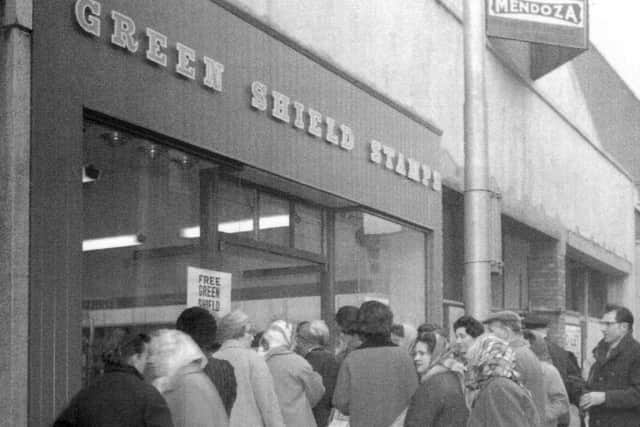MONICA MAKES SENSE: Flashback to the days of Green Shield Stamps
and live on Freeview channel 276
Who would have thought that our streets would be filled with white delivery vans bringing our internet purchases or our much welcome home deliveries of groceries? My mother wouldn't have liked it. She could spend all day shopping in the local shops although admittedly she did spend much of it chatting to other housewives outside the shops!
We have long been used to store cards and points that we accumulate when we buy petrol, but who remembers the excitement of Green Shield Stamps? I wonder if we would be as ready today to collect those little green squares and then spend hours sticking them into small books. Well, it was usually children who got the dreaded job of sticking them in. Pocket money hard earned! Some of us can remember the taste of the glue to this day!


Advertisement
Hide AdAdvertisement
Hide AdWhen I was growing up, the stamps were quite a big part of our lives. Started as a sales promotion or incentive loyalty scheme and to encourage customer loyalty, the Green Shield Trading Stamp Company was brought to the UK in 1958 by entrepreneur Richard Tompkins who bought the name ‘Green Shield’ from a luggage manufacturer, and they soon took off here in a big way.
The timing was good as the UK was enjoying a consumer boom in the 1950s after the depression of the war years. Wages were higher, employment was buoyant and there was a rise in the labour-saving devices that housewives realised would make their lives easier. Collecting these stamps would hopefully be a means of acquiring some of these household necessities.
It was no longer thought of as unacceptable to purchase things on the ‘never never’ and certainly after the Coronation, people started to look to having a television set as pride of place in their sitting rooms, courtesy of Wigfall’s or Bunney’s. It would though, be a massive task to save up enough stamps to actually own a small set, about 88 books in fact!
You could get the stamps at small businesses like corner shops and at petrol stations. You got one stamp for every sixpence spent with 280 stamps in each book. A complete book was worth £32 which would be around £350 today, and for just the one book you could claim exciting free gifts like a mouth organ, brush and comb set or even a set of lager glasses.
Advertisement
Hide AdAdvertisement
Hide AdTo start the collection of essential household items, 33 books w ould purchase a Kenwood Chef Food mixer! Mind you for your one thousand and sixty-four pounds you could have bought a small car then!
At the top end of the scale, for 170 books which was the equivalent of £5, 440, you could get a Silver Cloud motorboat, although with no outboard motor. Wasn’t it on everyone’s ‘must have’ list in those days when few people even had a car? And obviously it became so even into the 80s when the ‘special’ prize on ‘Bullseye’ was a speedboat!
Green Shield Stamps gave a new slant on collecting for your ‘bottom drawer’ which was what every newly engaged couple did, hoping to have at least enough bedding and tea towels to start them off in married life, although if they relied totally on the stamps it would have been best to have a very long engagement!
The Co-op also gave stamps. They were blue and introduced after the method of recording dividend, or divi as commonly known, became cumbersome. (Who remembers their mother’s dividend number? I know many people still do!)
Advertisement
Hide AdAdvertisement
Hide AdHistorically, member’s sales were recorded in ledgers in stores, but as societies grew it became a laborious task and so some stores started the savings stamps scheme. When the books were full, they could be paid for goods or into share accounts. I remember that my mother found the money from the savings books very useful when my sister and I required school uniform in the 1950s. The Co-op started another savings stamp scheme in 2013 where customers could purchase £1 stamps and if redeeming in December, receive a £2 bonus.
By the 1970s, the owner of Green Shield Stamps realised that the boom would not last for ever and the company was re branded as Argos with its first store opening in Canterbury in 1973. Richard Tompkins, on holiday in Greece, saw just the name for his stores when visiting the city of Argos.
After the closure of the Green Shield Stamp s hops, there was a transition period when you could still redeem Green Shield Stamps at Argos s tores either as full payment or part payment until the company completely suspended sale of stamps.
Argos stores remain popular in the UK to this day, although having been bought in 1998 by GUS plc and after that by the Homebase chain. The stores face stiff competition from many other retailers who have opted for Argos style shopping sections in their stores.
Advertisement
Hide AdAdvertisement
Hide AdThe name Green Shield Stamp became part of British retail folklore. Genesis in the song ‘Dancing with the Moonlit Knight’ mentions them and also Jethro Tull in the song ‘Broadford Bazaar’.
Michael Flanders refers to them in the opening patter to the Flanders and Swann song ‘Sounding Brass’.
Green Shield Stamp books, either full or empty can be bought today on eBay , and it seems that they can still be found when people are doing house clearances. Although there are probably far too many of them still around to be sought after as collectors’ items, it is interesting to see them and remember the days of sticking the stamps in and the taste of that glue!
In these confusing and worrying times, local journalism is more vital than ever. Thanks to everyone who help s us ask the questions that matter by taking out a subscription or buying a paper. We stand together. Nancy Fielder, editor.
Comment Guidelines
National World encourages reader discussion on our stories. User feedback, insights and back-and-forth exchanges add a rich layer of context to reporting. Please review our Community Guidelines before commenting.
